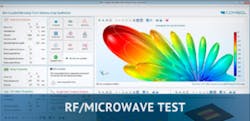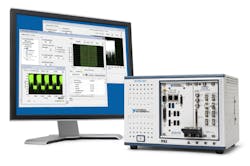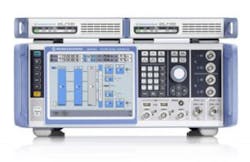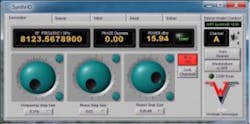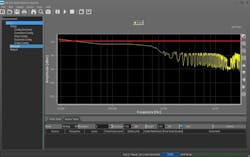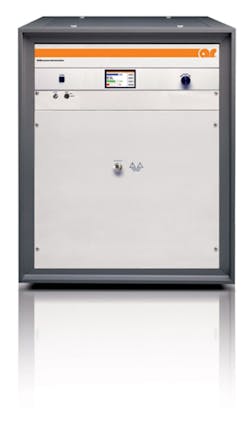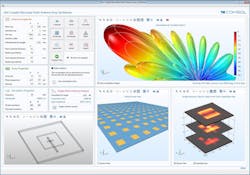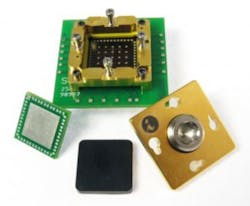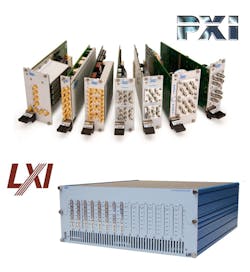Innovations span 5G and IoT to radar and threat simulation
RF/microwave test applications extending from the Internet of Things (IoT) and 5G to radar and threat simulation are areas of active engagement for test vendors. Relevant products range from software to modules, benchtop instruments, and complete test systems.
The International Microwave Symposium (IMS2016), scheduled for May 22-27 in San Francisco, will provide an opportunity for companies to highlight their offerings. Of particular interest will be test in accordance with 802.11 variants. National Instruments, Keysight Technologies, and Tektronix all plan to highlight such applications.
National Instruments will highlight two key applications: 802.11ax device testing and RF power amplifier (PA) and front-end module (FEM) testing. “With respect to 802.11ax, NI will be announcing the industry’s first 802.11ax test solution,” said David A. Hall, principal marketing manager for RF and wireless at NI. “This solution is based on the latest draft of the 802.11ax standard revision and uses waveforms that feature narrower subcarrier spacing, OFDMA technology, and the 1024-QAM modulation scheme.”
NI’s new 802.11ax approach is based on the NI PXIe vector signal transceiver, which combines a 6-GHz RF vector signal generator and analyzer, high-speed digital I/O, and a user-programmable FPGA within the same PXI module. The solution also uses NI’s WLAN Measurement software, which provides WLAN signal generation and analysis for waveforms ranging from 802.11a to 802.11ax. One of the key features of NI’s WLAN test methods is their flexible support of WLAN MIMO technology—which ranges from single-channel VSA/VSG-based approaches to eight-channel 8×8 MIMO test solutions.
In addition, NI will present both R&D and manufacturing test solutions for PAs and FEMs. “On the manufacturing test side, NI will be demonstrating high-volume production test of multiband LTE PAs,” Hall said. “This demonstration employs parallel test to improve overall test time and implements advanced test techniques such as FPGA-based digital predistortion (DPD). Using NI’s innovative FPGA-based DPD solution, engineers now are able to test PAs under DPD conditions in a manufacturing test environment.”
NI’s PA/FEM manufacturing test demonstration uses the Semiconductor Test System (STS). STS is a lower cost, higher throughput PXI-based alternative to traditional ATE. The demonstration features the same PXI instruments and measurement science as the RFIC test system designed for the R&D lab. By using the same measurement equipment from design through production test, engineers can better correlate measurement result data and decrease time to market. This STS is designed for WLAN, UMTS, and LTE RFIC testing and supports a complete array of measurements ranging from S-parameters to EVM and ACLR measurements.
Keysight will address a wide range of applications, with design, simulation, and test products for wireless communications (including 5G, IoT, and 802.11ad) and aerospace/defense (including radar, EW, Ka-band, and beyond).
“In particular, Keysight will be demonstrating application solutions that are built on a foundation of common building blocks that include software and hardware,” said Mario Narduzzi, communications solutions marketing manager at Keysight. “The software provides simulation, waveform creation, and analysis and runs on multiple hardware platforms to handle a range of customer needs. The robust hardware portfolio supports measurement needs up to millimeter-wave bands and includes signal analyzers, wideband oscilloscopes, arbitrary waveform generators, and vector signal generators. Specific solutions will focus on radar/EW, satellite, 5G, cellular coexistence between 5G and 4G waveforms, and wireless device design validation and manufacturing test for IoT.”
Among other exhibits, Keysight will highlight an updated version of its 5G Testbed Reference Solution, which can measure new 5G signal types being evaluated by research laboratories. “There are many factors to consider when evaluating new waveform types, including such things as spectral efficiency, latency, computational complexity, energy efficiency, the adjacent channel performance for coexistence, and implementation costs,” Narduzzi said. “We will help show attendees understand how to test these candidate waveforms and explore ‘what if’ scenarios for emerging 5G waveform applications.”
Courtesy of Keysight Technologies
Tektronix will address a range of applications at IMS, from radar and threat simulation to IoT and EMI precompliance. The company plans to highlight several products introduced within the last two months, including the RSA500 and RSA600 Series USB spectrum analyzers and an oscilloscope-based 802.11ad test solution.
Kip Pettigrew, product marketing manager, RF product line at Tektronix, said, “While the RSA500 Series has been optimized for field applications like network maintenance and spectrum management, the RSA600 is a natural fit for lab applications like EMI precompliance and transmitter PHY layer testing. We also have updated our RSA306B to include even better performance for a range of applications.”
The 802.11ad solution, he said, employs the 70-GHz DPO70000SX Series ATI oscilloscope powered by SignalVu Option SVM-30. “This powerful characterization and debugging solution provides the measurement industry’s most accurate and repeatable signal quality measurements for single carrier 802.11ad transmitter PHY at RF and is ideal for 802.11ad silicon and systems,” he added.
Pettigrew said Tektronix also will highlight threat simulation and radar test. The AWG70000 is a rugged, durable signal source that provides a wideband, high-resolution environment for threat simulation at speeds up to 50 Gb/s, he said. The AWG library of waveform-creation software includes SourceXpress, integrated waveform creation plug-ins, SerialXpress, and RFXpress, which have the tools necessary to create the signals of interest.
For radar, he said, “The fast and flexible AWG70000 offers an unmatched signal generation solution when powered by the comprehensive and easy-to-use RFXpress software. This solution can generate wideband RF signals above 11 GHz with an SFDR of 80 dB while creating complex test scenarios with powerful sequencing capability and RF signal playback.” In addition, he said, “The analysis solution of the RSA5200 with SignalVu software pairs well with the generation solution because it offers high performance in real time and the best triggering and allows all displays to be viewed simultaneously.”
Courtesy of Rohde & Schwarz
Rohde & Schwarz at this year’s IMS will showcase a variety of test and measurement instruments. For wideband communication standards such as 5G or IEEE 802.11ad, the company will demonstrate new capabilities for the R&S SMW200A vector signal generator, which, the company said, is the first to offer an internal modulation bandwidth of 2 GHz with a frequency range up to 40 GHz. Also highlighted will be the R&S FSW signal and spectrum analyzer, which the company says is the first offering frequency ranges up to 85 GHz and an analysis bandwidth of 2 GHz and a real-time bandwidth of up to 512 MHz. Both are user-friendly and commercial products for test needs around the still evolving 5G and other wideband standards.
For the automotive industry, in addition to the 85-GHz signal and spectrum analyzer, Rohde and Schwarz has introduced the Automotive Radar Target Simulator, which allows customers to simulate variable distance, variable speed, variable direction, and variable size targets and test their products (radar sensors) as these would operate in the real world.
Also on display will be the R&S FSWP phase noise analyzer and VCO tester, which now ranges up to 50 GHz. It combines extremely low-noise internal sources and cross-correlation technology, delivering high sensitivity for phase-noise measurements. As a result, it takes just seconds to measure even highly stable sources such as those found in radar applications.
Other presentations will center on VNAs and an up-converter for applications up to 750 GHz, a new lineup of fast and accurate USB and LAN power sensors up to 50 GHz, and new handheld spectrum analyzers and oscilloscopes that are equally capable of addressing measurement needs in the field and in the lab.
Low-cost modules
WindFreak Technologies will highlight a range of applications from system and device test to the general RF and microwave communications needs of the RF community, according to David Goins, chief technology officer. He added, “WindFreak offers low-cost RF and microwave modules such as RF signal generators, network analyzers, and frequency converters. These devices are controlled and programmed via a personal computer with intuitive software written in LabVIEW,” enabling engineers to easily integrate the devices into currently existing automated test environments. LabVIEW source code is provided with hardware purchases, he said, so engineers can cut, paste, or add new functionality quickly.
Courtesy of WindFreak Technologies
“The most striking feature of WindFreak’s products is the very low price for the performance delivered,” Goins said. “The WindFreak modules can perform at near test equipment levels but with price tags at 1/20th the cost.” For example, at $1,300, the SynthHD is a dual-channel, 54-MHz to 13.6-GHz RF signal generator with 0.1-Hz frequency resolution, 0.01-dB amplitude resolution, 0.01 degree relative phase resolution, +20-dBm output power, and 50-dB amplitude range; it can generate frequency-modulated continuous-wave radar chirps and offers other unique features. “All features are driven by an open source LabVIEW GUI that looks and feels like virtual benchtop test equipment,” he said. “The hardware weighs only a few ounces and is smaller than a deck of cards.”
Focus on EMI
Rigol Technologies will be emphasizing EMI. Jason Chonko, applications engineer, said, “In 2016, Rigol will be delivering a number of products aimed at enabling customers to perform common EMI precompliance test applications. Electromagnetic compliance testing can be an expensive and time-consuming step in the product development cycle. Precompliance testing techniques can be used to decrease both the time and money associated with product development and help get your product to market faster.”
He added, “Rigol will be introducing the Rigol NFP-3 series of near-field probes as well as an update to our EMI Test System Software. Near-field probes allow noncontact analysis of enclosures and board-level electromagnetic radiation when used with a spectrum analyzer. Users simply scan over their design with the probe and note the output radiation on the analyzer display. Near-field data can be used to pinpoint problematic areas of a design and solve them before the design goes out for final compliance testing.
“The new EMI Test System Software can be used with any Rigol DSA series spectrum analyzer to configure and collect data from precompliance test, including radiated and conducted emission sweeps,” Chonko continued. “This software eases the task of collecting data by automating analyzer setup (RBW, detector type, steps, and frequency range) and conveniently displays the scanned data in a concise report. It also includes correction tables, limit lines, peak detection, and graphing tools that help present the data in a clear and meaningful way.”
Courtesy of Rigol Technologies
Click image to enlarge
Joe Diesso, vice president of marketing at AR RF/Microwave, said the company will be focusing on EW, wireless, and EMC testing. Products on exhibit will include the 350S1G6 amplifier as well as the 300S1G6AB and other AB modules. Unique to the company, he said, are high-power broadband single-band amplifiers with touchscreen controllers.
Courtesy AR RF/Microwave Instrumentation
Tektronix, too, will be addressing EMI. Pettigrew said, “The RSA306B and MDO4000C make EMI/EMC precompliance and troubleshooting quick, clear, and inexpensive.” Customers, he said, can take a deep look at EMI issues with debug tools like DPX and domain correlation with RSA and SignalVu and perform easy system-level troubleshooting with synchronized analysis of analog, digital, and RF signals.
Software for design and test
Software, as well, will be a key topic. Jiyoun Munn, technical product manager, RF Module, COMSOL, said the latest release of his company’s RF Module software comes with a sample simulation app that simulates a single slot-coupled microstrip patch antenna fabricated on a multilayered low-temperature co-fired ceramic substrate. The results include the far-field radiation pattern of the antenna array and its directivity. The far-field radiation pattern is approximated by multiplying the array factor and the single antenna radiation pattern to perform an efficient far-field analysis without simulating a complicated full array model.
“We will be showcasing this app along with several others that support work toward 5G and the IoT,” he said. “We wanted to show designers how easy it is to build a simplified interface based on their COMSOL model in order to let anyone in the product development team test different operating conditions and configurations. Given how competitive will be the race to deliver the best 5G solutions, building simulation apps for an entire team will allow designers to share their expertise easily and free up resources to develop new concepts.” To run, the apps require COMSOL Multiphysics software and RF Module.
App simulating a single slot-coupled microstrip patch antenna
Courtesy of COMSOL
Click image to enlarge
Instrument makers will be highlighting software as well. As discussed by Hall at NI, “Simulation software such as NI’s AWR Design Environment is playing an increasingly important role in system design and prototyping. Using a combination of simulation software and modular instruments, engineers are increasingly able to prototype advanced systems,” ranging from radars to advanced DPD filters.
According to Pettigrew, “Tektronix test and measurement equipment imports and exports a variety of formats to help eliminate barriers between simulation and test. For example, Tektronix AWGs can stimulate the DUT using Matlab, .wfm, .cvs, .bin, and other generated waveform formats from simulation software. Furthermore, using waveform creation plug-ins SerialXpress or RFXpress, the waveforms can be conditioned to meet the simulation requirements.” In addition, signals captured using Tektronix oscilloscopes can be exported to other programs as .wfm, .csv, .bin, .trc, and .tr0 files to stimulate simulated DUTs with the help of TekScope Anywhere waveform analysis software. The signal import and export capabilities enable iterative design and the use of common analysis tools.
Narduzzi at Keysight added, “We are seeing more and more customers coming to us asking for solutions that include both simulation software and hardware for RF/microwave test. With Keysight’s Electronic Design Automation software that simulates a customer’s prototype design before fabrication, customers can complete their design cycles faster, at lower cost, and at lower risk, so many customers are turning to this approach.” Indeed, Keysight has been a pioneer in this area, as described in May article “Software strategy leverages design and test links.”
Connectors, sockets, and probing
Cascade Microtech will focus on on-wafer measurements for RFICs, including devices that operate at 79 GHz and beyond. A spokesperson explained that four-port S-parameter devices with pairs of balanced signals have the advantage of improvement in noise immunity and errors as opposed to conventional two-port devices. However, the on-wafer measurement required is exponentially more complex. At IMS, the company will showcase an integrated wafer-level measurement solution, a collaborative offering developed with Keysight Technologies for semi-automated four-port measurement and calibration at the 110-GHz frequency range.
Cascade’s technology relies on software as well. “A good proportion of Cascade Microtech customers are conducting RF test ultimately with the goal of creating a model that accurately characterizes device performance not only over a range of bias conditions, but also with the added complexity of different operating temperatures and, in some cases, different source and load impedances,” said the spokesperson. “The parameters associated with the model are both iteratively refined and tested for accuracy. The measurements must be accurate and traceable, which in turn require calibrations that are accurate and traceable.” Cascade’s WinCal XE, in conjunction with Keysight’s WaferPro Express, provides a platform together with Cascade’s Summit, CM300, or Elite 300 probe stations to take all the measurements required for successful model creation in an automated fashion, with the capability to archive the calibration error terms and raw data as well as the measurements themselves.
Darren Schauer, product manager, RF/microwave products, Molex, said the company will highlight its range of RF/microwave products, including more than 90 RF connector interface types. “The products and applications include Temp-Flex specialty wire and cable products and the SDP Telecom product portfolio, which ranges from complex surface-mount passive microwave structures to sophisticated subassemblies and integrated subsystems,” he said. Applications scheduled to be featured at the show will range from I/O to radar and include automotive, specialty cable, and cellular communications. In addition, he said, “Molex will be featuring a new Temp-Flex foam core cable, and RF connectors to test that cable are being developed to provide real-time data to customers.”
He continued, “For our SMPM and SMP RF connectors, the focus is on delivering high-density, high-frequency solutions, with tight board-to-board spacing.” He added that the Temp-Flex foam core cable’s mechanical characteristics deliver high phase stability while still providing exceptionally low loss across the transmission line. “We also are focusing on Dual and Quad FAKRA RF Connector Systems, which provide additional density compared to standard, individually soldered FAKRA systems, and mini-FAKRA Connector Systems that have a smaller footprint than standard FAKRA systems,” he said. In addition, Molex’s SDP Telecom subsidiary is highlighting its diverse range of radio link/backhaul products, passive and active RF components and subsystems for all cellular air interfaces, and distributed antenna system components and subsystems.
As for software issues, Schauer said Molex uses ANSYS HFSS to design its connectors; for test, it employs in-house network analyzers and vector network analyzers, which have their own software.
Courtesy of Ironwood Electronics
Ila Pal of Ironwood Electronics said the company will be addressing high-speed test for memory, logic, networking, 5G, radar, satellite communications, and other applications. The company will highlight a 75-GHz-bandwidth high-speed test socket that supports solderless assembly and is gold-plated for RF shielding.
RF signal switching
Bob Stasonis, sales and marketing director at Pickering Interfaces, said his company will focus on general microwave applications at IMS, with a particular emphasis on 6 GHz to 18 GHz. Nevertheless, the company offers a broad range of signal switching ranging from 300 MHz to 65 GHz. “Our goal is to provide switching modules that have specifications and pricing to make them attractive in many applications,” he said. “In the RF region, we have focused on expandable matrices to make it easier to build large RF matrices in PXI.”
Courtesy of Pickering Interfaces
Commenting on the unique features of his products, Stasonis said, “Pickering Interfaces now features eBIRST switching system test tools; these tools allow the test engineer to perform resistive testing of switch paths quickly and accurately. In addition, many of our microwave modules feature LED indicators that can assist in test program debug.”
Stasonis also weighed in on the relationships between high-speed digital test and microwave test: “The speed of serial buses is such that their signal paths have similar characteristics to RF signal paths. So a good knowledge of RF circuitry is required for digital engineering today.”
For more information
About the Author

Rick Nelson
Contributing Editor
Rick is currently Contributing Technical Editor. He was Executive Editor for EE in 2011-2018. Previously he served on several publications, including EDN and Vision Systems Design, and has received awards for signed editorials from the American Society of Business Publication Editors. He began as a design engineer at General Electric and Litton Industries and earned a BSEE degree from Penn State.
